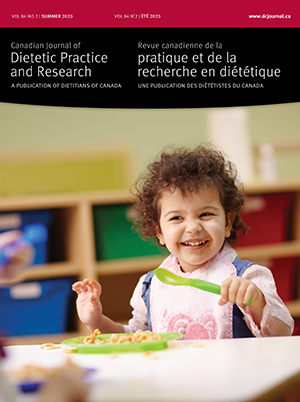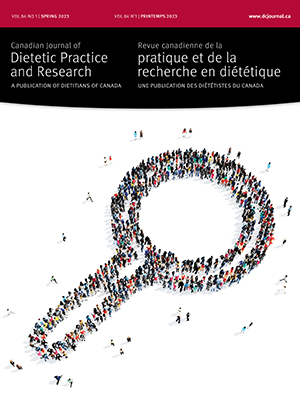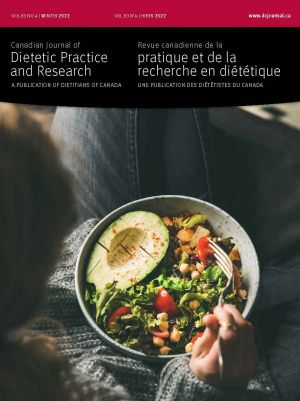Volume 66 • Number 2 • July 2005
Chair’s Message
Letters to the Editor
Research
Although a definitive relationship between diet and breast cancer remains controversial, many women adopt dietary change after diagnosis. To understand factors motivating dietary change, we explored the meanings that breast cancer survivors attached to food during recovery. Six women who were breast cancer survivors for six to 19 years participated in semi-structured interviews exploring personal meanings attached to food, dietary changes after diagnosis, factors influencing dietary change, and experiences with food in relation to breast cancer. Two distinct phases emerged. These corresponded to active treatment, when women used food to gain control, to cope, for comfort, and for hope, and to post-treatment, when the meanings that women attached to food were shaped by the perception of food's role in breast cancer causation. Women who believed that diet prevents a first diagnosis adopted change to prevent recurrence, while those who did not believe in the relationship between diet and breast cancer adopted change to improve health. In women with breast cancer, food can be an important coping mechanism. Women may benefit from counselling grounded in the meanings they attach to food over the recovery continuum.
Regular diet monitoring requires a tool validated in the target population. A 73-item, semiquantitative, self-administered food frequency questionnaire (FFQ), was adapted in French and English from the Block National Cancer Institute Health Habits and History Questionnaire. The FFQ was used to capture usual long-term food consumption among adults living in Quebec. A representative sample of adults aged 18 to 82 (57% female) was recruited by random digit dialling in the Montreal region. Approximately 64% of recruits completed and returned the instrument by mail (n=248). The FFQ was validated in a subsample (n=94, 61% female) using four nonconsecutive food records (FRs). Median energy intakes (in kcal) for men and women, respectively, were FFQ (total sample) 2,112 and 1,823, FFQ (subsample) 2,137 and 1,752, and FR (subsample) 2,510 and 1,830. Spearman correlation analyses between FFQ and FR nutrients were positive (with r ranging from 0.32 for folate to 0.58 for saturated fatty acids) and statistically significant (p<0.001), with better results among women. On average, cross-classification of energy and 24 nutrients from the FFQ and means of four FRs placed 39% into identical quartiles and 78% into identical and contiguous quartiles, with only 4% frankly misclassified. These results suggest that the FFQ is a relatively valid instrument for determining usual diet in Quebec adults.
To determine the health and social benefits of the family mealtime, we examined the contribution of immigrant mothers’ food motives to the importance placed on family meals, and cultural differences in mothers’ food motives and the importance ascribed to family meals. Data were taken from a study on food choice factors among ten- to 12-year-old children from three cultural communities in Montreal. A 24-item, self-administered questionnaire was used to explore food choice motives. Each mother was also asked how important it was for her family to take the time to eat together, and if the child enjoyed sharing meals with his or her family. In all, 209 of the 653 questionnaires distributed were valid; 68 were from Haitian, 75 from Portuguese, and 66 from Vietnamese mothers. Five factors emerging from factor analyses explained 61.67% of the variance. Analysis of variance indicated significant differences between mothers’ countries of origin for the importance placed on health, pleasure, familiarity, and ingredient properties (p<0.005). Among Haitian and Portuguese mothers, health motivations emerged as the only significant predictor of the importance given to family meals, whereas for Vietnamese mothers, both health and eating familiar foods were predictors (p<0.05).
Au Nouveau-Brunswick, il existe peu d'information qui décrit l'intégration de la recherche à la pratique diététique. Cette étude avait pour but de décrire la place de la recherche dans la pratique diététique et de déterminer le nombre de diététistes du Nouveau-Brunswick possédant une formation en méthodologie de la recherche. Un questionnaire validé a été posté aux membres de l'Association des diététistes du Nouveau-Brunswick. Un taux de participation de 76 % a été obtenu. Pour 85 % des diététistes, la scolarité la plus élevée est l'internat et 15 % possèdent un diplôme de cycles supérieurs. Cinquante-cinq pour cent des diététistes ont affirmé avoir une formation en méthodologie de la recherche. Les diététistes ayant une formation de cycles supérieurs percevaient moins d'obstacles à l'intégration de la recherche à la pratique. Quatre-vingt-un pour cent des diététistes ont cité le manque de temps alloué à la recherche au travail comme l'obstacle le plus important. Près des deux-tiers (63 %) ont affirmé qu'il est peu ou pas probable qu'elles entreprennent des études supérieures. La probabilité de poursuivre des études aux cycles supérieurs diminuait avec l’âge. Les obstacles à la poursuite d’études aux cycles supérieurs mentionnés dans 85 % des cas étaient « les obligations personnelles et familiales » et « le manque de temps ». L'attitude des diététistes néo-brunswickoises envers la recherche était par ailleurs positive.
Perspectives in Practice
Report
The psychosocial correlates of nutritional risk among older adults were examined in a study involving 54 people over age 65 (range, 65 to 98; average, 81), who were selected through a convenience sampling strategy. Measures included a background questionnaire, Mini Nutritional Assessment, Life Satisfaction Index Form Z, Geriatric Depression Scale, and Lubben's Social Network Scale. Seventeen percent of participants were found to be at risk of malnutrition. Compared with those who had adequate nutrition, at-risk participants had lower levels of social support (approaching statistical significance, p=0.08) and life satisfaction (not significant), and significantly higher levels of depression (p=0.04). Hierarchical multiple regression analysis showed that depression and social support were significant correlates of nutritional risk (p=0.01). Nutrition professionals should have a multidisciplinary perspective when they assess older adults’ nutritional status.
Review
Selenium is an essential trace element involved in several key metabolic activities via selenoproteins, enzymes that are essential to protect against oxidative damage and to regulate immune function. Selenium also may have other health benefits unrelated to its enzymatic functions. It may provide important health benefits to people whose oxidative stress loads are high, such as those with inflammatory or infectious diseases like rheumatoid arthritis or human immunodeficiency virus/acquired immunodeficiency syndrome, or who are at high risk for cancers, particularly prostate cancer. Some studies have generated compelling evidence that selenium is beneficial, either alone or in conjunction with other micronutrients. Additional data from large clinical trials that provide the highest level of evidence will be key to determining the benefits accrued at various selenium intake levels. When the strength of the evidence becomes sufficient, clinical health professionals will need to use dietary and clinical assessment methods to ensure that people at increased risk for cancer or inflammatory and infectious diseases can be appropriately advised about selenium intake.










